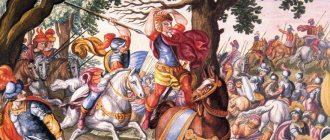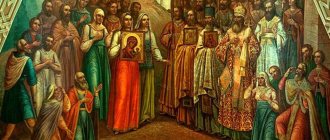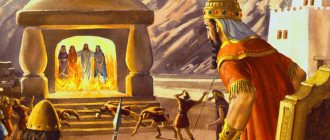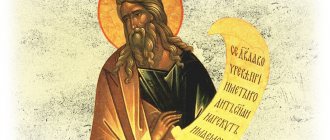Apocrypha (from ancient Greek - “hidden, hidden”) are works of late Jewish and early Christian literature that were not included in the biblical canon. The concept of “apocrypha” originally referred to the works of Gnosticism, which sought to keep its teachings secret. Later, the term “apocrypha” was attributed to early Christian texts that were not recognized as “inspired”: the Gospels, Epistles, Acts and Revelations that were not included in the Bible are considered by the Church to be “extraneous” or “non-canonical”, that is, apocrypha proper.
General definitions
According to the definition of the “Church Dictionary” by P. A. Alekseev (St. Petersburg, 1817), these are “hidden, that is, books published unknown from whom, or that are not publicly read in the church, as the Holy Scripture is usually read. Such books are all those that are not in the Bible.” That is, apocryphal books for the most part distort the principles of revealed teaching, and they cannot generally be recognized as divinely inspired (for example, due to the too strong element of human wisdom). Therefore, these books were mercilessly persecuted by the Fathers of the Church and were not included in the canon of revealed books of the Old and New Testaments (the Bible).
There are apocrypha that slightly diverge from Christian doctrine and, in general, confirm the Holy Tradition of the ancient Church, for example in iconography and worship: there is an apocrypha called the “Proto-Gospel of James” - it is not recognized by the Church as inspired scripture, but is accepted as evidence of Church Tradition. And most of the feasts of the Mother of God - the Nativity of the Virgin Mary, the Entry into the Temple, and partly the Annunciation (this was reflected in the iconography) are confirmed by the Proto-Gospel of James. This text is called apocrypha not in the sense that it contains something contrary to Holy Scripture. In many ways, it is simply a fixation of Church Tradition.
There is nothing hidden in the Gospel
The word “apocrypha” for many people, including sometimes those living church life, means something mysterious and incomprehensible. What is this - “secret knowledge” or simply part of the Tradition of the Church? Is it possible for an Orthodox Christian to read the Apocrypha? We talk about apocryphal texts with the secretary of the commission for the canonization of devotees of piety of the Saratov diocese, priest Maxim Plyakin.
— What are apocrypha in principle? What do you need to know about them so as not to perceive them as a mysterious something?
— The word “apocrypha” comes from a Greek word meaning “secret, hidden.” And this name is connected with the fact that the ancient Gnostics, in whose subculture apocryphal literature arose, contrasted their secret writings with the open and accessible Gospel of the Church. They tried to convey the idea that sacred books could only be accessible to a select few, and that what was open to the profane had no value. Consequently, initially the apocrypha are texts created outside the church tradition and deliberately opposed to the Gospel. But over time, researchers began to call this any non-canonical texts on biblical topics, including those that do not contradict the teachings of the Church.
— They don’t contradict, but the Church still doesn’t recognize them?
“They are not recognized as sacred, inspired books, but their content is reflected in the Tradition of the Church. Where, for example, do we know the story of the birth of the Virgin Mary, of Her entry into the temple? All this is described in the so-called Proto-Gospel of James - an apocryphal text attributed to the Apostle James, the brother of the Lord. We do not know who its author is, but scientists agree that this text was known among Christians already at the beginning of the 2nd century, that is, at a time when the direct disciples of the apostles were still alive. And the fact that the celebration of these events became part of the church tradition suggests that the first generations of Christians recognized them as true.
Another similar example is the story of the end of the earthly life of the Blessed Virgin Mary, on the basis of which the Feast of the Assumption was established. The narration is told on behalf of the Apostle John the Theologian, but this is a text of the 4th–5th centuries; its author could not possibly have been the Evangelist John. And the Church denies this text the right to be in the New Testament, but recognizes that it reflects real events.
And there is, for example, such a text as “The Gospel of Thomas.” It is very different in form from the canonical Gospels: there is no narrative - only the sayings of Jesus Christ. As stated in the manuscript, these are “the secret words that the living Jesus Christ spoke and which Didymus Judas Thomas wrote down” - this is the full name of the apostle. Saint Clement of Alexandria in the 3rd century, when asked whether the contents of this text could be trusted, said that it undoubtedly contained fragments of the authentic sayings of the Lord. But the very mention of “secret” words indicates that the manuscript came to us from the Gnostics - and the real words of Christ are diluted in it with such an amount of Gnostic poison that the Church as a whole cannot accept this text.
— How was reliability and unreliability determined?
— First of all, the question was posed like this: to what time does this text go back to and to whose authorship? Did it arise in the circle of the apostolic disciples, does it have anything to do with the apostles themselves? Naturally, when the history of Christianity was only a hundred or a couple of hundred years old, it was quite easy to determine this. Next, they determined how much what is written in the text corresponds to what the Church received through the apostolic preaching. Confidence in the authenticity of this sermon was higher than confidence in any name with which the text was signed.
One of the early Christian fathers said: “It is not the Eucharist that is tested by Scripture, but Scripture is tested by the Eucharist.” This is probably difficult for a non-church person to understand, but any believer, a person consciously staying in the Church, understands: above all is the real presence in the Church of Christ Himself, in Whom its existence is created. And if for this life in Christ what is said does not turn out to be foreign, it is accepted.
It is amazing that in different parts of the Christian world, in an era when there was no communication between cities and countries even remotely resembling modern ones, different church communities made the same judgment: only the four Gospels are completely authentic. We do not have such spiritual experience, so we do not understand how this can be. But the first Christians were not struck by this.
— Are there any myths and superstitions in the Orthodox community that arose precisely on the basis of the apocrypha?
— I would say that this is not a specific myth or superstition, but a certain ideological inclination. The tendency to consider God as the giver of miracles for the sake of the miracles themselves, for the sake of their external effect. In the apocrypha, Christ is often depicted this way, especially in those that deal with the childhood of the Savior. We know that the Gospel speaks very briefly about the childhood and adolescence of Christ. And the authors of non-evangelical texts are trying to cover these, as it seems to them, blind spots in the most bizarre way. It is described how little Christ sculpts birds from clay - and they come to life and fly away, how, in response to the evil words of one of the neighbor boys, He kills him with one single word. This is amazing, but it is not at all in the spirit of the Gospel. A gospel miracle never happens “just like that”; it is always connected with the salvation of a person. Christ calls Peter, and he walks on the water - here the power of faith is revealed to us; Christ raises up the righteous Lazarus - and on the eve of His suffering confirms both His resurrection and the future general resurrection of the dead. But people are looking for fabulous miracles - they are looking for some old man in the Church from whom clay birds will fly away. Apocryphal “fables,” as the Apostle Paul says, fuel this thirst. But in the Gospel it is no coincidence that we are given the words of Christ Himself: an evil and adulterous generation seeks a sign; and no sign will be given to him (Matthew 12:39). We are told directly: do not seek miracles—seek the Kingdom of Heaven, and the rest will be added to you.
— Until when were new apocrypha created?
- Throughout our era, right up to this day. In this sense, we can talk about the Old Testament apocrypha, which was written by the Jews at the end of the Old Testament era, during the years of Christ’s earthly life. Later, texts arose that correlated in form with the letters of the apostles. In the Middle Ages, the Gnostic idea of secret spiritual knowledge was developed by the Albigensian movement; they had their own writings - apocrypha of the 11th-12th centuries. Strange as it may sound, some works of Russian writers can also be classified as apocrypha. Let's say Lev Nikolaevich Tolstoy wrote a “gospel” for children, in which he expressed his own teaching. This text does not reflect the story of the Nativity of Christ, it does not tell about the miracles of the Lord, since the writer considered the Savior only a virtuous teacher of morality - and, of course, it does not contain the resurrection of Christ, since Leo Tolstoy did not believe in him. It turns out that in this presentation of the Gospel events the Gospel meaning is completely lost, although there is nothing fictitious there.
Isn’t the story about Yeshua in the novel “The Master and Margarita” apocryphal? This is an anti-gospel - it is not for nothing that Woland, that is, the devil, tells this story in Bulgakov. And here we again see that there are no miracles, that the Kingdom of Heaven is preached by a half-crazed wandering philosopher. Before us is not the omnipotent Lord - the tamer of the storm on Lake Gennesaret. And not the Son of God, Who from the Cross promises the thief a meeting in paradise. But in this way, Mikhail Afanasyevich seems to warn: look, the one who will tell you about such a Jesus is not speaking for himself, he is only voicing the story, the author of which is Woland.
At the beginning of the twentieth century, the so-called “Tibetan Gospel” was popular, which is actually the literary work of Nikolai Notovich, the fruit of his imagination. He claimed that while traveling in Kashmir he discovered a manuscript entitled “The Life of Saint Issa, the Best of the Sons of Men.” It allegedly tells that before His preaching in Palestine, Jesus spent many years in India and Tibet, studying with the gurus there, that on the Cross He fell into a state of trance, and his body, which received astral characteristics, was transferred to the East. There He lived for many more years, died and was buried. Research and reviews of this book by orientalists have shown that this is not even a retelling of some Tibetan legends, but simply a fake, a lie. But for a certain circle of people, representatives of the intelligentsia, this book became a temptation.
The question arises: why did the author write all this? The key point here is that Christ is not resurrected in this book. “If Christ has not been raised, then your faith is vain,” said the Apostle Paul (1 Cor. 15:17). And this desire to convince Christians of the futility of faith in Christ the Savior is what motivates the creators of this kind of newly invented apocrypha.
— Several years ago there was big news in the media that a certain “Gospel of Judas” had been found. What kind of “revelations” are these, why did they excite people so much?
— I would say that in these attempts to excite the commercial component is primary. The existence of such a text has been known since at least the 4th century - it is a typical Gnostic apocrypha associated with a specific mythological system. Nowadays, for the first time, this text has been found in its entirety, hitherto known only in fragmentary retellings; in 2006, after research, it was published - the media tried to make a sensation out of this.
Compared to other Gnostic monuments, there is nothing unusual there - all the gospel meanings are turned upside down. Judas is presented as the closest disciple of Christ, who committed betrayal as a personal feat for the sake of fulfilling the plan to crucify the Lord. In this paradigm, the act of Judas is placed on a par with the ministry of the Savior Himself, because he is an instrument of redemption from the sin of the human race. In this perception of Judas, I repeat, there is nothing new - church polemicists have debunked this idea since ancient times. But today it turned out to be beneficial to get this Gnostic pathos out of the dusty chest - “but we know how everything really happened...”; in a modern society hungry for edgy entertainment, it is in demand. This is also why there was such a fuss about the movie "The Da Vinci Code", where the whole idea is built around the fact that Jesus Christ had a wife and offspring, and this line of descendants continues to this day. People who watch such films with interest would like all church history, all church commandments to turn out to be lies. And they themselves are among the spiritually chosen who have risen above deceived humanity. Behind all this is a fruitless desire to humiliate Christianity, and in this sense, between the Jewish forgery - the "Genealogy of Jesus", the Gnostic forgery - the "Gospel of Judas", the Muslim forgery - the "Gospel of Barnabas", the occultist forgery - the "Gospel of Peace from the Essenes" - there is no fundamental difference.
— Is it worth reading the Apocrypha for an Orthodox Christian to broaden his horizons? At least those apocryphal works that are not anti-church in meaning.
“I think that if a person understands what kind of texts are in front of him, then this reading will not harm him. But you need to be as careful as with medicines on the pharmacy shelf - if used inappropriately, you can get poisoned. However, as the sad history of mankind shows us, people sometimes manage to read the New Testament in such a way that they fall into delusion. So it's a question of reasonableness of perception. I would advise you to take not just a collection of apocrypha, but a research work that contains a sober view and analysis. For example, the book by historian Boris Derevensky “Jesus Christ in the Documents of History.” It is written from a non-church perspective, but its author is an honest researcher. He prefaces each published fragment with a preface, where he examines the historical context of the appearance of this text and shows the conflict between the apocryphal worldview and the church one. This helps to get a truly objective view.
Newspaper "Orthodox Faith" No. 04 (648)
Fighting the Apocrypha before the Nativity of Christ
Apocryphal books arose long before Christianity. Soon after the return of the Jews from Babylonian captivity, the Old Testament priest Ezra made an attempt to collect (and separate from the false apocrypha) all the holy books, then still scattered and partially lost. With his assistants, Ezra managed to find, correct/translate into modern language, supplement and systematize 39 books (in the Tanakh of the Jewish tradition they were artificially combined into 22 books - according to the number of letters in the Hebrew alphabet). Those apocryphal books that contradicted the selected books, diverged from the traditions of the Old Testament legend, were infected with pagan myths and superstitions of neighboring peoples, containing occult practices and magical spells, as well as books that did not have religious value (household, entertaining, children's, educational, love, and other nature), were strictly eliminated (sometimes mercilessly destroyed) and were not included in the Old Testament, and later in the Christian Bible. Later, some of these apocrypha nevertheless became part of the Talmud, Mishnah and Gemara used by Judaism.
Orthodoxy does not welcome apocryphal books
Orthodox priests do not recommend paying special attention to apocryphal books. The apocrypha, whether Christian or Jewish, runs counter to Orthodox teaching.
And here, in the information space, where Christians celebrate Maundy Thursday and Maslenitsa, and also do not know who God the Father is, it would be harmful to fill the heads of parishioners with apocryphal parallels. We don’t know our own theology!
But for a person well acquainted with faith, a religious scholar or a competent theologian, it is very interesting to know various aspects of the apocrypha:
- Ideas;
- Motives for writing;
- Time of creation;
- Artistic techniques.
The Apocrypha is a trace of intra-religious polemics.
With their help you can determine:
- what thoughts had weight in the past;
- what views could have gained weight today if history had turned out differently;
- what sources influenced the biblical authors;
- what stories are excluded from the biblical text;
- what circumstances exist that expand and clarify the stories from Holy Scripture.
By leaving a comment, you accept the user agreement
Deuterocanonical books
After the death of Ezra, his followers (zealots of piety) continued their search, and those books that were found were relevant and those that were written in subsequent centuries (for example, the Maccabees) were selected by them as inspired. But the rigor and meticulousness of the selection, as well as the indisputable authority and traditions of Ezra, did not allow innovations to be introduced into the established canon of the Holy Books. And only in the fairly free and enlightened city of Alexandria, where there was a rich library of antiquity, when translating the Old Testament books into Greek, 72 Jewish interpreters and translators, after deep study, diligent prayers and debates, added (in the Greek text) to the previous 39 books 11 books. It was this version (Septuagint) that became the main one for Christians who spoke predominantly Greek in the first centuries of Christianity.
When Protestants, using ancient handwritten originals, began to translate the Bible into modern national languages, they discovered the absence of these 11 books in all Jewish texts and hastened to declare these books apocrypha (although they did not prohibit them, but only declared them of little importance). It should be noted that even some canonical books (which do not confirm their views) raise doubts among Protestants.
These 11 non-canonical (deuterocanonical) books, that is, books not included in the original canon of Ezra, are revered in Orthodoxy in the same way as all other books of the Bible; they are also used during public worship (read in proverbs), along with the canonical ones. Nowadays, thanks to the successes of biblical archeology, Jewish texts previously considered lost have also become known for some books.
The Apocrypha is divided into Old Testament and New Testament
All apocrypha can be grouped, following the example of the Bible, into two large bodies:
- Old Testament Scriptures;
- New Testament texts.
The Apocrypha of the Old Testament was primarily written in the first centuries BC within the Jewish tradition. But not all. For example, there are Slavic texts:
- Slavic version of the life of Adam and Eve;
- Jacob's Ladder.
It is unlikely that these texts were originally written in Rus', but it was here that they gained popularity.
Slavic apocrypha The Life of Adam and Eve was written on behalf of Eve after her expulsion from the Garden of Eden
One of the most informative Old Testament apocrypha is the book of Jubilees. This is an analogue of the book of Genesis, which significantly complements and expands information from the canonical books of the Old Testament.
The favorite topics of the authors of this category of apocrypha are the lives of the first people and the testaments of the Jewish patriarchs. The authors of such writings are least interested in the numerous books of the prophets. Almost nothing has been written about them.
II-IV century
the texts of the apocrypha of the New Testament were written
The Apocrypha of the New Testament basically retells, supplements and contradicts the canonical gospels. These texts were written mainly during the dawn of Christianity in the 2nd–4th centuries.
Very prolific authors of the New Testament apocrypha are Gnostics. This is one of the first Christian schools. It is distinguished by a mystical interpretation of the Holy Scriptures, which brings Gnosticism closer to Eastern esotericism, and not to Jewish traditions.
Among the Gnostic gospels, the following are widely known:
- Gospel of the Egyptians;
- Gospel of Truth;
- Gospel of Judas;
- Gospel Mani;
- Gospel of Eve;
- Gospel of Mary;
- Gospel of Nicodemus;
- Gospel of Thomas.
See also the article The Gospel of Judas
Apocrypha
divided into Old Testament writings and New Testament texts
The Apocrypha introduces another genre that does not exist in the Bible: the childhood gospels. These are texts telling about the first years of Christ’s life, as well as about the events preceding His birth. Widely known:
- "Gospel of Childhood";
- "The Gospel of Pseudo-Matthew";
- "The Gospel of Jacob";
- "The Book of Joseph the Carpenter";
- Arabic "Gospel of Childhood";
- "Jesus in the Temple";
- "The Gospel of Apelles";
- "The Secret Gospel of Mark";
- "Proto-Gospel of Jacob";
- "The Gospel of Andrew";
- The Childhood Gospel of Thomas.
It is curious that although the Bible has two unique books - Acts and the Apocalypse, in apocryphal literature they have turned into popular genres, of which there are many examples: the Acts of Philip, the Acts of Paul, the Acts of the Holy Apostle Thaddeus, one of the twelve, the Martyrdom of the Holy Apostle Paul, the Apocalypse of Peter , Apocalypse of Paul, Apocalypse of John (non-canonical) and other apocryphal books on these topics.
Various epistles are equally abundantly represented - the Epistle of Abgar to Christ, the Epistle of the Apostle Peter to the Apostle James, etc.
Fragment of the manuscript Apocalypse of Peter (Apocrypha)
There are apocryphal works of other genres that are not represented in the Bible:
- The Mother of God's journey through torment;
- The Apostle Paul's journey through torment;
- Conversation of the Three Saints;
- The Descent of Christ into Hell.
The fight against the apocrypha after the Nativity of Christ
With the rise of Christianity, there was an even greater need to separate the officially accepted books of the Bible from the various alternative apocryphal interpretations written at different times and by different people. Some of them were written by completely pious, albeit naive, people who wanted to explain and supplement the Holy Scriptures in their own way (for example, “The Virgin’s Walk through the Torments” describes the descent of the Mother of God into hell and then her representation before the throne of the Son). Other apocrypha were born in various widespread early Christian sects, and heretical movements and in Gnosticism using Christian themes. There were also authors who specifically, allegedly on behalf of the apostles revered in Christianity, compiled and distributed “messages” that were compromising the official Church, which, in their opinion, hid the originally true teaching. Therefore, Christians at all times tried to defend, from their point of view, the true “purity of their faith,” and at all times, at councils, they compiled lists of renounced books (apocrypha), which were forbidden to be read, and which were searched for, torn, burned, or cleared/washed off parchments apocryphal texts and other palimpsests were written.
In modern Christianity, only 27 books are included in the New Testament canon and are recognized as inspired books, which, according to the church, were written directly by the apostles (secular witnesses of Christ). The composition of the New Testament canon is enshrined in the 85th Apostolic Canon. Together with the books of the Old Testament, they form the Christian Bible, which contains a total of 77 books. It is all these inspired books that are considered the only authoritative source in matters of sacred history and dogma in the main Christian denominations.
However, the writing of inspired books did not stop with the death of the apostles. The Orthodox Church has been replenished and continues to be replenished with a huge number of works (writings) of the Holy Fathers, liturgical texts and descriptions of the lives of saints, which, after a careful and comprehensive study for compliance with the Holy Scriptures (Bible), are also recognized as inspired and obligatory for all Christians. Therefore, these religious books, which are not directly part of the Bible, are not considered apocrypha.
The ancient apocrypha that has survived to our time has not only historical significance, but to some extent also dialectical, since they reflect the views of Christians of the first centuries.
The apocrypha includes the so-called Old Testament apocrypha, apocryphal Gospels, Acts, Apocalypses, etc., as well as alternative “official” biographies of saints.
Apocrypha is also composed in our time, when various sects, certain “elders”, soothsayers and “miracle workers” publish and distribute religious literature that interprets in their own way the history and principles of Christian doctrine.
Differences between apocryphal literature and canonical literature.
There are several principles that distinguish apocryphal literature from canonical literature.
| Apocryphal literature | Canonical literature |
| Texts are not "inspired" | Texts considered "divinely inspired" |
| Apocrypha is prohibited from reading in church | Bible texts read in church |
| Apocryphal texts are often controversial; the facts described are not confirmed in other historical documents | Facts described in canonical texts are often confirmed in other sources |
| Basic ideas often contradict the teachings of the Church. | The main ideas are in agreement with the teachings of the Church. |
| The texts are often gnostic or heretical in nature | The texts are recognized by the Christian Church and are included in the Biblical canon |
| Apocryphal texts based on Biblical events were written much later than the canonical books | Many canonical Books were written by eyewitnesses of events or their students |
Apocryphal literature arose long before the spread of Christianity. It is known that Ezra, after returning from Babylonian captivity, tried to collect and categorize all the sacred tests known at that time. Ezra, and not only he, was particularly selective about texts that were written under the obvious influence of occult practices or pagan myths. Such texts, which contradict traditional traditions, were often deliberately destroyed. However, it is worth emphasizing that most of the Old Testament apocrypha was included in the Talmud; Kabbalah also abounds in them.
By the way, Ezra considered 39 sacred texts traditional (canonical), which still form the basis of the Old Testament canon. Alexandrian theologians added 11 more books to these books, which today in the Orthodox tradition are considered deuterocanonical. Unlike apocryphal texts, the texts of the deuterocanonical books are used in worship.
The issue of separating apocryphal literature from canonical literature was also very relevant for early Christianity. A new wave of apocryphal texts appeared in which authors of different backgrounds and varying degrees of literacy, based on different goals, tried to supplement the Holy Scriptures. We should not forget that this was the time of the spread of various early Christian sects and speculation on religious themes. Many authors tried to add authority to their texts by signing the names of the apostles revered at that time. Many authors of early Christian apocrypha believed that the official Church was hiding the true teaching from Christians and tried to correct this “error.”
In response to the wave of appearance of a large number of new apocrypha, the official church began to defend the purity of the Holy Scriptures and made attempts to combat apocryphal literature by:
- compiling lists of prohibited heretical texts,
- destruction of apocryphal texts;
- refuting false teachings and criticizing the actions of false teachers.
The pinnacle of the struggle against apocryphal literature was the approval of the New Testament canon of 27 books. The composition of the New Testament canon was fixed by the 85th Apostolic Canon.
For a long time, the status of one or another apocryphal book was decided at numerous councils.
Apocrypha of the Old Testament
Psalms of Solomon
Testaments of the Twelve Patriarchs
Ethiopian Book of Enoch
Slavic Book of Enoch
Syriac and Greek Apocalypses of Baruch (Vision of Baruch)
Ascension of Moses
Book of Jubilees
Martyrdom of Isaiah
Job's Testament
Jewish sections of the Sibylline books
Isaiah's Vision
Abrahamic Covenant, Abrahamic Revelation, Death of Abraham
Melchized








